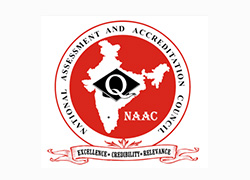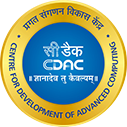National Assessment and Accreditation Council (NAAC)
National Assessment and Accreditation Council (NAAC)
About NAAC
 The National Assessment and Accreditation Council (NAAC) was established in 1994 as an autonomous institution of the University Grants Commission (UGC) with its Head Quarter in Bengaluru. The mandate of NAAC as reflected in its vision statement is in making quality assurance an integral part of the functioning of Higher Education Institutions (HEIs).
The National Assessment and Accreditation Council (NAAC) was established in 1994 as an autonomous institution of the University Grants Commission (UGC) with its Head Quarter in Bengaluru. The mandate of NAAC as reflected in its vision statement is in making quality assurance an integral part of the functioning of Higher Education Institutions (HEIs).
The NAAC functions through its General Council (GC) and Executive Committee (EC) comprising educational administrators, policymakers and senior academicians from a cross-section of Indian higher education system. The Chairperson of the UGC is the President of the GC of the NAAC, the Chairperson of the EC is an eminent academician nominated by the President of GC (NAAC). The Director is the academic and administrative head of NAAC and is the member-secretary of both the GC and the EC. In addition to the statutory bodies that steer its policies and core staff to support its activities, NAAC is advised by the advisory and consultative committees constituted from time to time.
Vision & Mission
Vision
To make quality the defining element of higher education in India through a combination of self and external quality evaluation, promotion and sustenance initiatives.
Mission
- To arrange for periodic assessment and accreditation of institutions of higher education or units thereof, or specific academic programs or projects
- To stimulate the academic environment for the promotion of quality of teaching-learning and research in higher education institutions
- To encourage self-evaluation, accountability, autonomy and innovations in higher education;
- To undertake quality-related research studies, consultancy and training programs
- To collaborate with other stakeholders of higher education for quality evaluation, promotion and sustenance
Value Framework
- To promote the following core values among the HEIs of the country:
- Contributing to National Development
- Fostering Global Competencies among Students
- Inculcating a Value System among Students
- Promoting the Use of Technology
- Quest for Excellence
Assessment & Accreditation
The NAAC has been set up to facilitate the volunteering institutions to assess their performance vis-a-vis set parameters through introspection and a process that provides space for participation of the institution.
Benefits of Accreditation
- Institution to know its strengths, weaknesses, and opportunities through an informed review process
- Identification of internal areas of planning and resource allocation
- Collegiality on the campus
- Funding agencies look for objective data for performance funding
- Institutions to initiate innovative and modern methods of pedagogy
- New sense of direction and identity for institutions
- The society look for reliable information on quality education offered
- Employers look for reliable information on the quality of education offered to the prospective recruits
- Intra and inter-institutional interactions
Eligibility Criteria
Higher Education Institutions (HEIs), with a record of at least two batches of students graduated or been in existence for six years, whichever is earlier, are eligible to apply for the process of Assessment and Accreditation (A&A) of NAAC, and fulfill all the specified conditions.
Units of Assessment
NAAC's instrument is developed to assess and grade institutions of higher education through a three-step-process and make the outcome as objective as possible. Though the methodology and the broad framework of the instrument is similar, there is a slight difference in the focus of the instrument depending on the unit of Accreditation, i.e., Affiliated/Constituent Colleges/Autonomous Colleges/Universities/Health Science/Teacher/Physical Education.
Criteria and Weightages
NAAC has identified a set of seven criteria to serve as the basis of its assessment procedures. NAAC has categorized the Higher Educational Institutions into three major types (University, Autonomous College, and Affiliated/Constituent College) and assigned different weightages to these criteria under different key aspects based on the functioning and organizational focus of the three types of HEIs. The criterion-wise differential weightages for the three types of HEIs are:
- Curricular Aspects
- Teaching-Learning and Evaluation
- Research, Innovations and Extension
- Infrastructure and Learning Resources
- Student Support and Progression
- Governance, Leadership and Management
- Institutional Values and Best Practices
Grading
Institutions are graded for each key aspect under four categories, viz. A, B, C and D, denoting Very good, Good, Satisfactory and Unsatisfactory levels respectively. The summated score for all the Key Aspects under a Criterion is then calculated with the appropriate weightage applied to it and the GPA is worked out for the Criterion. The Cumulative GPA (CGPA), which gives the final Assessment Outcome, is then calculated from the seven GPAs pertaining to the seven criteria, after applying the prescribed weightage to each criterion.
Grievance Redressal
To provide a review mechanism for institutions who are aggrieved about the process or its outcome or any other issues related thereof, the NAAC has evolved Grievance Redressal Guidelines.
Re-Assessment
Institutions, which would like to make an improvement in the accredited status, may volunteer for re-assessment, after completing at least one year, but not after the completion of three years. The option can be exercised only once in a cycle. The re-assessed institution cannot come for another re-assessment in the same cycle.
Cycles of Accreditation
Institutions, which would like to make an improvement in the accredited status, may volunteer for Re-assessment, after completing at least one year but not after the completion of three years.
Assessment Outcome
The final result of the Assessment and Accreditation exercise will be an ICT based score, which is a combination of evaluation of qualitative and quantitative metrics. This will be compiled as a document comprising three parts:
- Peer Team Report
- Graphical Representation Based on Quantitative Metrics (QnM)
- Institutional Grade Sheet
Useful Links
Source: National Assessment and Accreditation Council (NAAC)
Last Modified : 5/18/2021
This topic provides information about national oly...
This topic provides information about Role of Nur...
The topic covers details of UN Convention on the '...
This topic covers the Information related to Legal...
